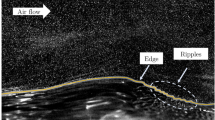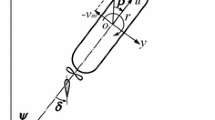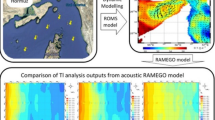Abstract
Ship capsizes in the extreme weather condition are difficult to predict, even though they cause a great number of casualties. Numerical methods have been developed to analyze the capsize phenomena and to predict the possible capsizes. The visual simulation can augment the physical evaluation of ship motion and validation of the experimental results. However, most of the existing visual simulations merely focus on the normal ship motion in general sea state and have less fascinating visual effect (VFX) compared with those in movie industry. In this paper, we propose a visual simulation method to generate stormy wave surface, to simulate wave properties such as splash and wake using particle simulation, to render the wave and its relevant stormy features and finally to compose the visual effects together. Wave simulation is based on the modified Tessendorf grid method of ocean wave, and SPH particles are adopted to simulate the wave properties. Lastly, the integrated rendering is to produce the scene of ship motion in storm condition.













Similar content being viewed by others
References
Balakhontceva, M., Karbovskii, V., Sutulo, S., Boukhanovsky, A.: Multi-agent simulation of passenger evacuation from a damaged ship under storm conditions. Procedia Comput. Sci. 80, 2455–2464 (2016). https://doi.org/10.1016/j.procs.2016.05.547
Kang, Yuna, Kim, Hyunki, Han, Soonhung: Visualization of the synthetic environment data representation & interchange specification data for verifying large-scale synthetic environment data. J. Def. Model. Simul. 12(4), 507–518 (2015)
Darles, E., Crespin, B., Ghazanfarpour, D., Gonzato, J-C.: A survey of ocean simulation and rendering techniques in computer graphics. In: Computer Graphics Forum, vol. 30, no. 1, pp. 43–60. Blackwell Publishing Ltd (2011)
Claes, P.: Controlling fluid simulations with custom fields in Houdini Master Thesis (2009)
Visual effects breakdown of “The Life of Pi”. https://www.youtube.com/watch?v=HcBSLwnKciw&t=33s
Visual effects breakdown of “The Perfect Storm”. https://www.youtube.com/watch?v=W9Tdw5nG4dQ
Visual effects breakdown of “the Low Budget Perfect Storm”, https://www.youtube.com/watch?v=W9Gyb7hkDCU
Wu, E., Zhu, H., Liu, X., et al.: Vis. Comput. 23, 299 (2007). https://doi.org/10.1007/s00371-007-0106-y
Miandji, E., Sargazi Moghadam, M.H., Samavati, F.F., et al.: Real-time multi-band synthesis of ocean water with new iterative up-sampling technique. Vis. Comput. 25, 697 (2009). https://doi.org/10.1007/s00371-009-0352-2
Wang, C., Zhang, Q., Kong, F., et al.: Hybrid particle–grid fluid animation with enhanced details. Vis. Comput. 29, 937 (2013). https://doi.org/10.1007/s00371-013-0849-6
He, J., Chen, X., Wang, Z., et al.: Real-time adaptive fluid simulation with complex boundaries. Vis. Comput. 26, 243 (2010). https://doi.org/10.1007/s00371-010-0426-1
Layton, A., van de Panne, M.: A numerically efficient and stable algorithm for animating water waves. Vis. Comput. 18, 41 (2002). https://doi.org/10.1007/s003710100131
Tessendorf, Jerry: Simulating ocean water. Simulating nature: realistic and interactive techniques. SIGGRAPH 1(2), 5 (2001)
Wu, B., Yan, X., Wang, Y., Wei, X.: Maritime emergency simulation system (MESS)—a virtual decision support platform for emergency response of maritime accidents. In: 2014 4th International Conference on Simulation and Modeling Methodologies, Technologies and Applications (SIMULTECH), Vienna, Austria, 2014, pp. 155–162. https://doi.org/10.5220/0005039401550162. http://ieeexplore.ieee.org/stamp/stamp.jsp?tp=&arnumber=7095015&isnumber=7094932
Stewart, W.K.: Visualization resources and strategies for remote subsea exploration. Vis. Comput. 8, 361 (1992). https://doi.org/10.1007/BF01897122
de Kat, J.O., Paulling, J.R.: Simulation of ship motions and capsizing in severe seas. Trans. Soc. Naval Archit. Mar. Eng. 97, 139–168 (1989)
Belenky, V.L., Sevastianov, N.B.: Stability and safety of ships: risk of capsizing, 2nd edn. Society of Naval Architects and Marine Engineers, Jersey City, NJ (2007)
Paroka, Daeng, Ohkura, Yuuichi, Umeda, Naoya: Analytical prediction of capsizing probability of a ship in beam wind and waves. J. Ship Res. 50(2), 187–195 (2006)
Ruponen, P.: Progressive flooding of a damaged passenger ship. Helsinki University of Technology (2007)
Papanikolaou, A.: Review of damage stability of ships—recent developments and trends. In: Proceedings 10th Int. symposium on practical design of ships and other floating structures (PRADS) 2007. Houston (2007)
Dankowski, D.H.: A fast and explicit method for simulating flooding and sinkage scenarios of ships. TUHH Universitätsbibliothek (2013). https://doi.org/10.15480/882.1125
Ueng, Shyh-Kuang: Physical models for simulating ship stability and hydrostatic motions. J. Mar. Sci. Technol. (Taiw.) 21, 674–685 (2013). https://doi.org/10.6119/JMST-012-1121-1
Ueng, S.K., Lin, D., Liu, C.H.: Virtual Real. 12, 65 (2008). https://doi.org/10.1007/s10055-008-0088-8
Varela, J.M., Rodrigues, J.M., Guedes Soares, C.: 3D simulation of ship motions to support the planning of rescue operations on damaged ships. Procedia Comput. Sci. 51, 2397–2405 (2015). https://doi.org/10.1016/j.procs.2015.05.416
Zhang, X., Jin, Y., Yin, Y., Li, Z.: Ship simulation using virtual reality technique. In: VRCAI (2004)
Kobyliński, Lech: Stability of ships: risk assessment due hazards created by forces of the sea. Arch. Civil Mech. Eng. 8(1), 37–45 (2008)
Yeo, Dong Jin, Cha, Moohyun, Mun, Duhwan: Simulating ship and buoy motions arising from ocean waves in a ship handling simulator. Simulation 88(12), 1407–1418 (2012)
Sandaruwan, Damitha, Kodikara, Nihal, Keppitiyagama, Chamath, Rosa, Rexy: A six degrees of freedom ship simulation system for maritime education. Int. J. Adv. ICT Emerg. Reg. 3(2), 34–47 (2010)
Varela, J.M.: Virtual reality models for ship damage control (2014)
Yuksel, C., House, D.H., Keyser, J.: Wave particles. In: ACM SIGGRAPH 2007 papers (SIGGRAPH ‘07). ACM, New York, NY, USA, Article 99 (2007). https://doi.org/10.1145/1275808.1276501
Horvath, P., Illes, D.: Sph-based fluid simulation for special effects. In: The 11th Central European Seminar on Computer Graphics, 23–25 April 2007 Budmerice, Slovakia (2007)
Funding
The research presented in this paper is conducted as a part of Master Thesis, which is funded by iCAD laboratory in mechanical engineering of KAIST.
Author information
Authors and Affiliations
Corresponding author
Ethics declarations
Conflict of interest
The authors declare that they have no conflict of interest.
Electronic supplementary material
Below is the link to the electronic supplementary material.
Rights and permissions
About this article
Cite this article
Wang, L., Han, S. Visual simulation of a capsizing ship in stormy weather condition. Vis Comput 35, 1855–1868 (2019). https://doi.org/10.1007/s00371-018-1579-6
Published:
Issue Date:
DOI: https://doi.org/10.1007/s00371-018-1579-6




